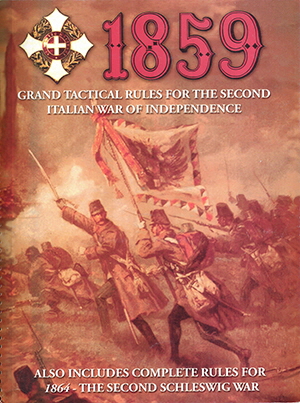
 No matter how well proofed, it seems, there’s always a few goofs, omissions, or clarifications that need to be addressed in any product as detailed as 1859. Here’s a few that have come up; I’ll try to address and post others that alert readers may bring to my attention on this site as they come up.
No matter how well proofed, it seems, there’s always a few goofs, omissions, or clarifications that need to be addressed in any product as detailed as 1859. Here’s a few that have come up; I’ll try to address and post others that alert readers may bring to my attention on this site as they come up.
- In the photo of the French corps on page 2, there should be a horse artillery battery included with the attached cavalry division.
- On page 18, the manner in which charging cavalry and counter-charging cavalry are brought together by pro-rating their movement means that the charging cavalry – with their charge bonus – will always have more movement remaining after a collision than the defending cavalry. The appropriate sentence describing this is now corrected to read: “If there is a counter-charge, the defender also rolls for a charge bonus in the same manner, and attacker and defender are placed together at some likely spot long the route of charge at the defender’s discretion.”
- The columns shifted on the Morale Rating Modifiers table on page 23. “- If attacked or shot in the rear” should be in the Minus THREE column, not the Minus ONE column.
- On page 87, in the last sentence of the Success paragraph, there’s a reference to “double firepower benefits”. This should read “-2 fire modifier”.
- In the Points per paragraph on page 91, the Fire Points sentence could have been more clear. It should read: All Fire Points per stand remain as in the half-scale version: 1 for all infantry stands and 2 for Jägers at medium-to-long range; 3 for Prussian infantry and 4 for Prussian Jägers at close range.
- On the Morale Rating Modifiers table on page 88, in the Minus THREE column, the “- If attacked or shot in the rear” was inadvertently left out entirely.
- In the 18 April Dybbøl scenario, the promised allotment of Prussian command stands was inadvertently left out of the scenario OB. They should be: One 3-horse (divisional) stand for Gen Manstein; two 2-horse brigade command stands, and five 1-horse regimental commanders with the assault columns; one brigade command stand and two regimental command stands with the 10th, 11th, and 12th Brigades, and one each with the combined Guard brigades grouping.
- On the 1859 Cheat Sheet, the “- If cavalry attacking steady infantry/square” modifier should be added to the Minus THREE column. [The morale tables on pages 25 and 91 are correct, as is the one on the 1864 Cheat Sheet].
- On the 1864 Cheat Sheet, it was intended that all figures reflect the Quarter Scale measurements – but somehow the firing ranges on the Artillery and Rifle tables were never changed. Those ranges should be double the ones shown. All other measurements are correct on the Cheat Sheet.
- Concerning artillery usage. It was common practice during this era to group two, three, or four batteries on the battlefield whenever possible (without regard for unit affiliation) into ad hoc “battalions”. Each of these artillery groups/battalions would engage common targets under the direction of the senior artillerist present. The Artillery Tables in all the Grand Tactical Rules games were calibrated to give the most accurate results when two or three grouped batteries engage the same target simultaneously, i.e., with one die roll. This I tried to encourage in the rules by subjecting lone batteries to severe morale penalties. At the same time, the Artillery Table compensates individual batteries somewhat by inflating their chances of inflicting damage on a target for playability’s sake …but as “single stand units” there is a big penalty to pay for operating independently. The individual batteries lose Morale Points three times as fast as multiple-stand “battalions.”
- The rule should be, therefore, that if two or three batteries are grouped together to gain the “battalion” morale benefit, they must all engage the same target as well, massing their points and firing on it with a single die roll.
 Continuing play of the Grand Tactical rules resulted in the appearance, in 2017, of a completely revised fast-play version of the 1859 rules. These are compatible with (but much faster than) the original 1859 rules, and I regard these to be the definitive version of the series. New quick reference sheets (and a summary of changes) for 1859 and 1866 are available here. Improved ways of organizing your half and quarter-scale Austrian battalions, melees in towns, and several other improvements are also covered in the 1866 booklet, which continues to use the original point-attrition and combat resolution system.
Continuing play of the Grand Tactical rules resulted in the appearance, in 2017, of a completely revised fast-play version of the 1859 rules. These are compatible with (but much faster than) the original 1859 rules, and I regard these to be the definitive version of the series. New quick reference sheets (and a summary of changes) for 1859 and 1866 are available here. Improved ways of organizing your half and quarter-scale Austrian battalions, melees in towns, and several other improvements are also covered in the 1866 booklet, which continues to use the original point-attrition and combat resolution system.

